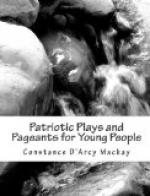BARBARA.
With Fawnfoot yonder. She taught me to play games,
and angle for fish,
and——What be they staring at?
BRADFORD (dryly). Goodwife Williams, for children that rouse a village there is but one remedy.
GOODWIFE WILLIAMS
(humbly).
A physic?
BRADFORD (almost roaring). No! A slipper! See that it is administered. And light songs, such as we heard but now, are scarcely seemly on a young one’s lips. She should learn graver measures.
[In groups of twos and threes the Puritans solemnly exeunt, left, Bradford marching ahead. Fawnfoot, with agile grace, disappears into background, dancing with her own shadow as she goes. Philippe and Goody Gurton are left alone. Philippe bends over the ducking-chair, and with his knife cuts the thongs which bind Goody Gurton, the while he talks, half-tenderly, half-gaily, for the first time allowing a hint of accent to creep into his speech.
PHILIPPE. They do not even stop to unbind thee! It is a strange thing, this witchcraft, that so turns the head!
GOODY GURTON. You do for me what others do not do—you whom I have scarcely seen before!
PHILIPPE. A good deed sown is ofttimes a good deed reaped. So say they in la belle France, and my tongue loves the words. ’Twas long ago that you did a kindness for me when my father lay ill of a fever; but—I—I have not forgotten. (He cuts the final thong that binds her.) Whither now, Goody Gurton? Nay, it would seem that we have need of each other. For you—a shoulder to lean on: for me—often I am lonely. I think what it would mean in my hut in the forest to look up and see a grand’mere sitting there! We be two outcasts; but the woods are kind. There is a song about that oversea: it says—
(Sings)
Blue the sky above you,
Dans la foret;
True the hearts that love you,
Courageux et gai!
Come, Grand’mere, home!
[They exeunt right, he bearing himself with a proud erectness, she leaning upon his shoulder with the peaceful dependence of a soul whose problem is solved. The scene ends.
COSTUMES
The Puritan women and girls wear black dresses with white lawn kerchiefs and cuffs, and Puritan caps. One or two of the women wear black cloaks, falling to the edge of their gowns. The material of which these dresses and cloaks may be made is black cambric with the glazed side turned in. The kerchiefs and cuff of lawn or white cheesecloth.
For the men and lads full black knee-breeches, black doublets with the sleeves a little fulled; white cuffs and Puritan collars. Long black cloaks ankle-length. Beaver hats. Any well-illustrated edition of “Pilgrim’s Progress” will give an excellent idea of these costumes. (See notes on Hawthorne Pageant, page 220.)
PHILIPPE BEAUCOEUR. Philippe Beaucoeur wears a tan-Colored costume cut on Indian lines (supposedly dressed deerskin) with a sash of scarlet, such as the French voyageurs were in the habit of wearing. A fur slung across his shoulders and caught at his girdle. The costume is fringed, Indian-like, but is not painted Of beaded. The breeches come to the knee. Tan stockings and moccasins. The costume made of cotton khaki.




